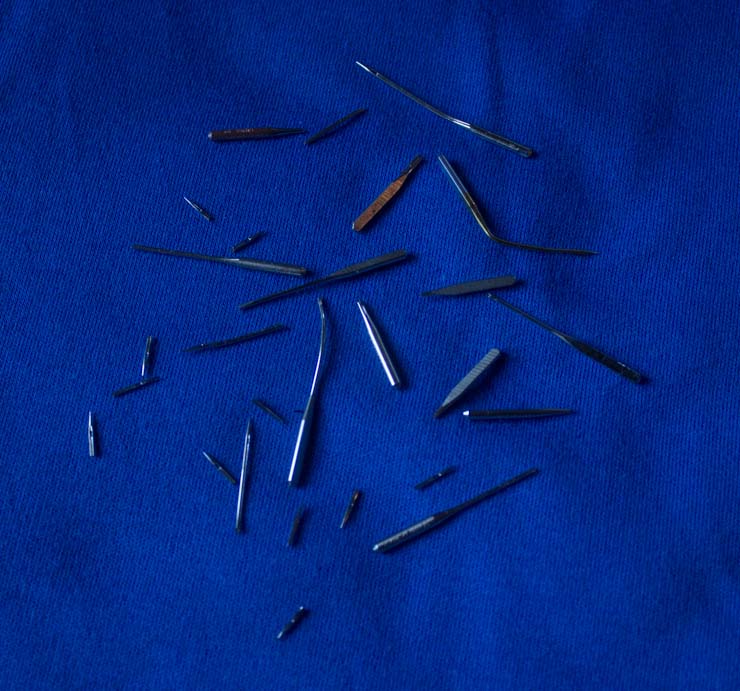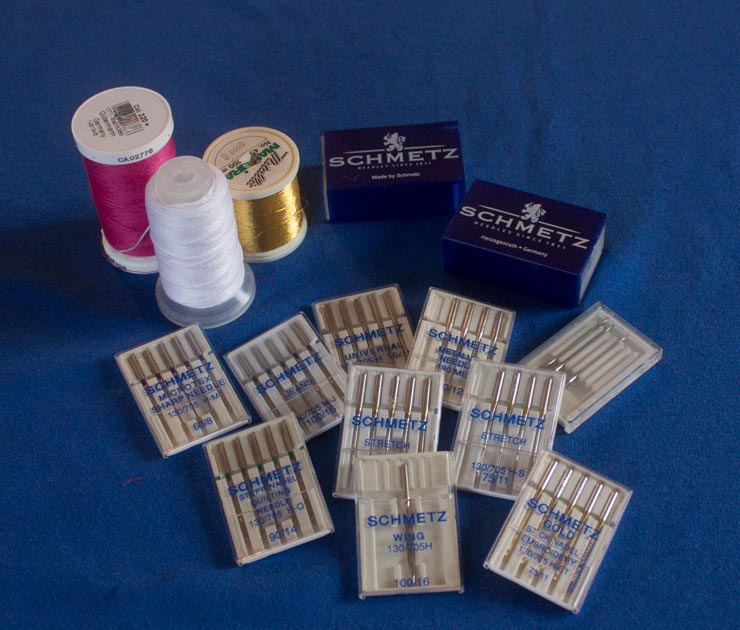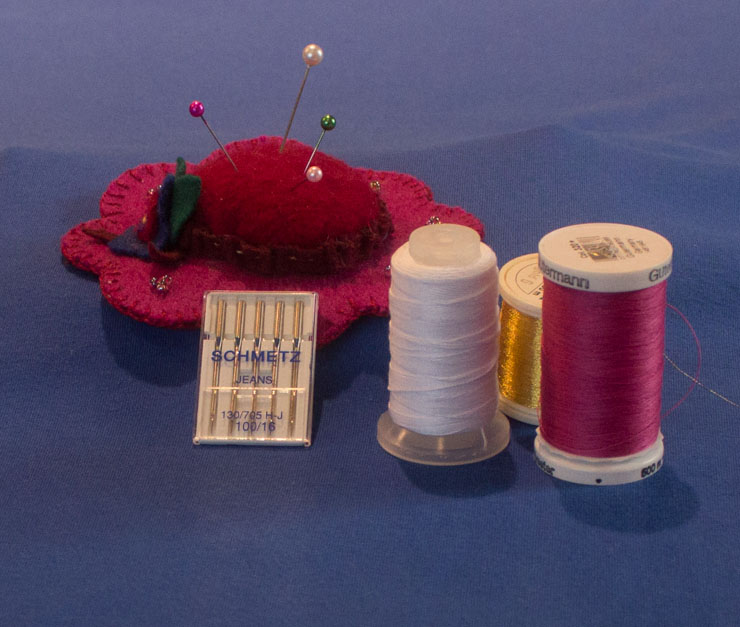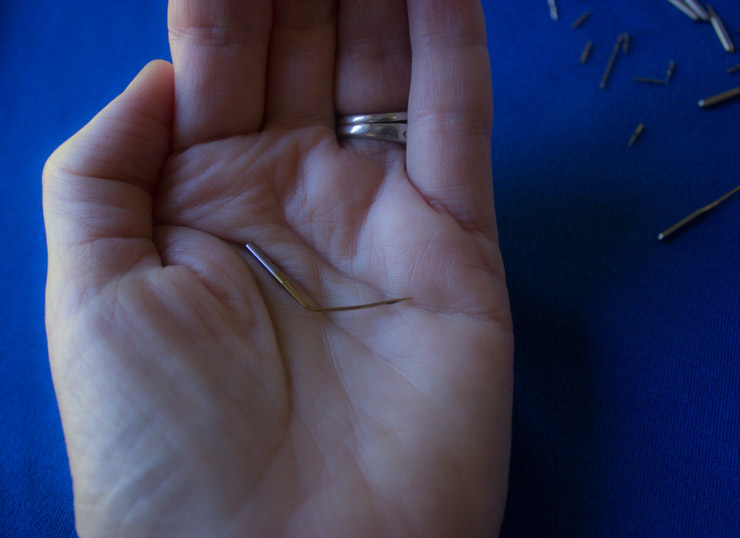Some people never change their sewing machine needles unless they break. Do.Not.Be.That.Person. You paid good money for your fabric, and a dull needle can damage it. How happy are you going to be when stitching up the final seam on your uh-mazing new dress, and BAM!—the needle punches a big hole or causes a run in your fabric?
Sewing machine needles have a life span, and it is rather a short one at that! Eight hours, people. Eight hours of stitching time, max. Personally, I think it is a little tough to track hours of stitching time. It is easier to change the needle every project, or every other project if you are doing something quick. At a minimum you are saving yourself skipped stitches, and potentially much bigger problems. And since most needles cost less than a dollar, really, what’s your hangup with throwing away a needle, anyway?
Now, let’s get down to it. You need to know a few needle facts. Let’s cover the basics first.
Types of Needles
There is a wide selection of needle types. You need to select the type of needle that is appropriate to do the job.You wouldn’t build a cabinet using a sledge hammer, and the same principle of fitting the appropriate needle to the task applies.
Ball Point Needle
Made especially for sewing knit fabrics. The rounded tip of the needle “pushes†the knitted fibers apart so the point does not break the fibers and cause a “run†or “laddersâ€; same concept as getting a “run†in your pantyhose (does anyone wear pantyhose anymore?).
Denim/Jeans Needle
Duh. Just like the name implies, this needle is for denim. And it also works for any densely woven materials such as imitation leather or home dec fabrics. This is a very strong + sharp needle.
Double Eye Needle
This “specialty†needle is often used for embroidery and topstitching with decorative threads. It has two eyes so you can try sewing with 2 different colors of thread.
Double Needle (Twin Needle)
These specialty needles were designed for producing a RTW-looking hem, but can also be used for decorative topstitching. Since there are 2 needles on a single shaft, this needle produces 2 rows of parallel stitches at the same time. There are double Universal, Denim, Machine Embroidery, Metallic, and Stretch needles available. One caution: the distance between the two needles varies, so be sure to select a needle that will fit into the hole in your presser foot as well as the hole in the stitch plate of your machine.
Embroidery Needle
In addition to a long smooth groove and a large eye, embroidery needles also have a special “scarf†on the back of the needle. All of these characteristics help protect the fragile specialty embroidery threads by guarding against excess friction.
Gold Embroidery Needle
Similar to an embroidery needle, but with a special Titanium Nitride ceramic coating. This helps improve needle wear resistance in high stitch count applications and penetration of coarse or densely woven materials.
Hemstitch Needle
A specialty needle, also known as a “wing†needle, that creates decorative openwork or cut-work on tightly woven fabrics.
Leather Needle
Duh. These needles have a darn sharp cutting point that is needed for leather and imitation leather.
Metallic Needle
Have you ever tried sewing metallic threads without this needle? A “must haveâ€for sewing with metallic and other specialty threads because the elongated eye prevents shredding and breaking of metallic threads.
Microtex Sharp
This little baby is a very slender needle with a thin shaft that helps make very straight stitches. It was originally developed for the modern micro- fibers, polyesters, and high thread count, high quality fabrics. Try it for topstitching or edge stitching! This needle needs to be changed more frequently because it is a bit more fragile than most needles. (Pssst! I use these when I make dress shirts for my DS andDH. PERFECT for edgestitching!)
Quilting Needle
Made especially for piecing and machine quilting, the thin tapered design of these needles allows them to pass through many layers smoothly to help eliminate skipped stitches and keep stitches even.
Self-Threading Needle
This specialty needle can be helpful for children, those with vision problems, or those with fine motor coordination issues resulting from arthritis or other conditions.
Stretch Needle
NOT to be confused with a ball point/jersey needle designed for knits! These needles are made especially for synthetic suede or highly elastic synthetic knit wear. Great for stitching through elastic because of a special coating that prevents “loops†from pulling out of the elastic.
Topstitch Needle
These needles have an extra large eye and large grooves to accommodate the heavier weight of topstitch/denim/buttonhole twist threads.
Triple Needle
Like a twin needle, only more so. 😉
Universal Needle
This is your basic workhorse. A general purpose needle that can be used on knit or woven fabrics. It has is great for zigzag stitching, does not damage knits, and is still sharp enough to go through a lot of different types of fabrics. Because of the slight ball point it is not ideal for going through many layers or high thread count fabrics.
Needle Sizes
In addition to the variety of needle types listed above, needles come in a range of sizes. The smallest is 8/60, and the largest is 20/120. These numbers are actually reflective of the 2 different numbering systems used to classify needles. The U.S system range is 8-20, and the European system is 60-120. So, the finer the fabric being sewn, and the finer the thread being used, the smaller the needle you should select. Logical, right? 😉
Putting It All Together
Alright, friends. Now that you have the basic facts about needles, how do you choose the right needle for the job? There is a little science and a little art involved in this. The 2 factors that control your decision are the type of fabric and the weight of the thread. For example, cotton lawn or voile is lightweight fabric, so you know right away you want a small needle. It is a natural fiber, so probably a universal tip is best. Microtex is not required because lawn is not a tight weave, and Ballpoint/Jersey is out because it is not a knit. I would start with a Universal 8/60, and because this small needle has a correspondingly smaller groove in the front and a smaller eye, I would also choose a lighter weight thread. Something like a 50 wt cotton.
The thread you select should not occupy more than 40% of the eye of the needle. That is a little-known fact you can toss out at your next cocktail party conversation to look all witty and smart (or maybe just all-sewing-geeky-like! 🙂 ). If I was sewing a rayon/lycra Ponte weight dress, I would start with a Ballpoint/Jersey size 70 or 80—depending on the weight of the Ponte. I would also use a standard 40 wt polyester thread.
The art part of the proper needle selection means you need to experiment a little. Better to do this on scrap fabric rather than your actual garment, BTW. 😉 Sometimes it seems like a size 80 will be perfect, but on your sewing machine the stitches look better with a size 70. after a while you will learn what works best for your machine and your fabrics, but it never hurts to run a few tests to see how things look.
Really. I don’t even know how that hot-mess-of-a-needle even happened! I am blaming a student. 😉
Want to know my pet peeve regarding needles? When people think a stretch needle is for all knits. I will call you out if I hear you making that mistake! 😉
Happy sewing!
Maris




